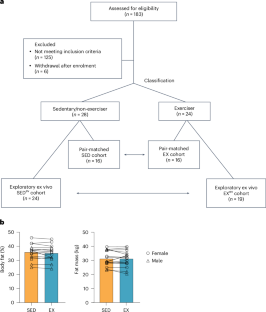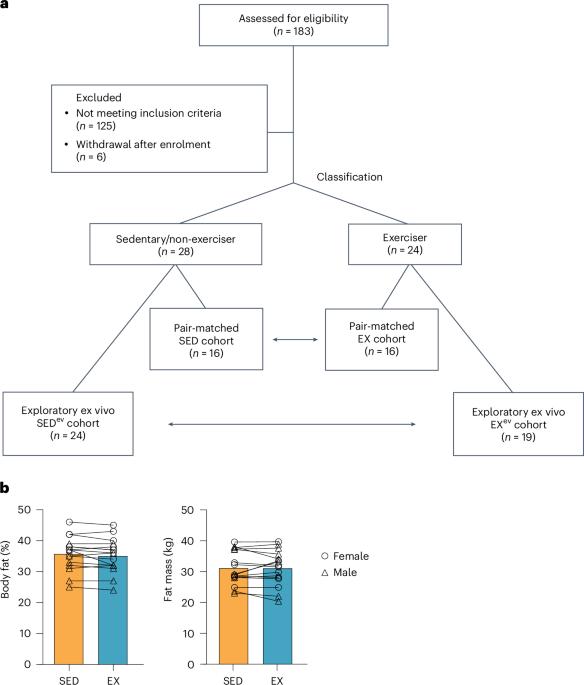多年耐力运动训练重塑超重或肥胖成人的腹部皮下脂肪组织
IF 18.9
1区 医学
Q1 ENDOCRINOLOGY & METABOLISM
引用次数: 0
摘要
腹部皮下脂肪组织(aSAT)的结构和代谢功能异常是许多与肥胖有关的健康并发症的根源。耐力锻炼能改善超重或肥胖成年人的心脏代谢健康,但耐力训练对腹下脂肪组织的影响尚不清楚。我们纳入了经常锻炼的超重或肥胖男性和女性参与者,他们锻炼了>2年,并将他们与匹配良好的非超重或肥胖锻炼者进行了横向比较。结果显示,与非运动者相比,运动者的 aSAT 具有更高的毛细血管密度、更低的 Col6a 丰度和更少的巨噬细胞。与此同时,血管生成蛋白、核糖体蛋白、线粒体蛋白和脂肪生成蛋白的丰度更高。从运动者体内收集的 aSAT 中,参与蛋白质翻译、脂肪生成和转录本直接调控的磷蛋白含量也更高。探索性体内外实验表明,与非运动者相比,从运动者身上采集的 aSAT 培养样本具有更强的血管生成能力和更高的脂质储存能力。经常锻炼可能会重塑 aSAT 结构和蛋白质组特征,从而有助于保持心脏代谢健康。本文章由计算机程序翻译,如有差异,请以英文原文为准。


Years of endurance exercise training remodel abdominal subcutaneous adipose tissue in adults with overweight or obesity
Abnormalities in the structure and metabolic function of abdominal subcutaneous adipose tissue (aSAT) underlie many obesity-related health complications. Endurance exercise improves cardiometabolic health in adults with overweight or obesity, but the effects of endurance training on aSAT are unclear. We included male and female participants who were regular exercisers with overweight or obesity who exercised for >2 years, and cross-sectionally compared them with well-matched non-exercisers with overweight or obesity. Here we show aSAT from exercisers has a higher capillary density, lower Col6a abundance and fewer macrophages compared with non-exercisers. This is accompanied by a greater abundance of angiogenic, ribosomal, mitochondrial and lipogenic proteins. The abundance of phosphoproteins involved in protein translation, lipogenesis and direct regulation of transcripts is also greater in aSAT collected from exercisers. Exploratory ex vivo experiments demonstrate greater angiogenic capacity and higher lipid-storage capacity in samples cultured from aSAT collected from exercisers versus non-exercisers. Regular exercise may play a role in remodelling aSAT structure and proteomic profile in ways that may contribute to preserved cardiometabolic health. Adults with overweight or obesity who exercise regularly for at least 2 years exhibit distinct structural and proteomic characteristics in abdominal subcutaneous adipose tissue that may contribute to better cardiometabolic health outcomes.
求助全文
通过发布文献求助,成功后即可免费获取论文全文。
去求助
来源期刊

Nature metabolism
ENDOCRINOLOGY & METABOLISM-
CiteScore
27.50
自引率
2.40%
发文量
170
期刊介绍:
Nature Metabolism is a peer-reviewed scientific journal that covers a broad range of topics in metabolism research. It aims to advance the understanding of metabolic and homeostatic processes at a cellular and physiological level. The journal publishes research from various fields, including fundamental cell biology, basic biomedical and translational research, and integrative physiology. It focuses on how cellular metabolism affects cellular function, the physiology and homeostasis of organs and tissues, and the regulation of organismal energy homeostasis. It also investigates the molecular pathophysiology of metabolic diseases such as diabetes and obesity, as well as their treatment. Nature Metabolism follows the standards of other Nature-branded journals, with a dedicated team of professional editors, rigorous peer-review process, high standards of copy-editing and production, swift publication, and editorial independence. The journal has a high impact factor, has a certain influence in the international area, and is deeply concerned and cited by the majority of scholars.
 求助内容:
求助内容: 应助结果提醒方式:
应助结果提醒方式:


